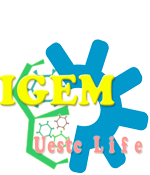Team:UESTC Life/Safety
From 2013.igem.org
(→Basic Safety Questions for iGEM 2013) |
(→Basic Safety Questions for iGEM 2013) |
||
| Line 157: | Line 157: | ||
<html> | <html> | ||
<div align="right"> | <div align="right"> | ||
| - | <a href="https://2013.igem.org/Team:UESTC_Life#/page/ | + | <a href="https://2013.igem.org/Team:UESTC_Life#/page/1"><img src="https://static.igem.org/mediawiki/2013/6/68/Uestclifeback.png" /></a> |
</div> | </div> | ||
</html> | </html> | ||
Latest revision as of 03:32, 27 September 2013
| Safety |
|---|
Basic Safety Questions for iGEM 2013
1. Please describe the chassis organism(s) you will be using for this project. If you will be using more than one chassis organism, provide information on each of them:
| Species | Strain no/name | Risk Group | Risk group source link | Disease risk to humans? If so, which disease? | |
|---|---|---|---|---|---|
| 1 | E. coli (K12) | MC1061 | 1 | www.absa.org/riskgroups/bacteria search.php?genus=&species=coli | NO |
| 2 | DH5α | MC1061 | 1 | www.absa.org/riskgroups/bacteria search.php?genus=&species=coli | NO |
2. Highest Risk Group Listed:
1
3. List and describe all new or modified coding regions you will be using in your project. (If you use parts from the 2013 iGEM Distribution without modifying them, you do not need to list those parts.)
| Part number. | Where did you get the physical DNA for this part (which lab,synthesis company, etc) | What species does this part originally come from? | What is the Risk Group of the species? | What is the function of this part, in its parent species? | |
|---|---|---|---|---|---|
| 1 | BBa_OHC01 | Synthesized, Genscrip | Sphingobium japonicum UT26S | 1 | Degrade Organohalogen
compounds |
| 1 | BBa_OHC02 | Synthesized, Genscrip | Sphingobium japonicum UT26S | 1 | Degrade Organohalogen
compounds |
| 1 | BBa_OHC03 | Synthesized, Genscrip | Rhodococcus Rhodochrous | 1 | Degrade Organohalogen
compounds |
| 1 | BBa_OHC04 | Synthesized, Genscrip | Agrobacterium tumefaciens | 1 | Degrade Organohalogen
compounds |
4. Do the biological materials used in your lab work pose any of the following risks? Please describe.
- a. Risks to the safety and health of team members or others working in the lab?
No, Whoever working in our lab has to wear gloves, lab-gown, and mask.
- b. Risks to the safety and health of the general public, if released by design or by accident?
NO,others can't use our organism without permission and the organism will die in a short time without culture medium.
- c. Risks to the environment, if released by design or by accident?
NO, the all waste culture medium and bacterium solution have been sterilized before pull into disposal bottle.
- d. Risks to security through malicious misuse by individuals, groups, or countries
No, all team members are undergraduate students in our college. Everyone are positive and can dispose some problem calmly.
5. If your project moved from a small-scale lab study to become widely used as a commercial/industrial product, what new risks might arise? (Consider the different categories of risks that are listed in parts a-d of the previous question.) Also, what risks might arise if the knowledge you generate or the methods you develop became widely available? (Note: This is meant to be a somewhat open-ended discussion question.)
NO, our project is aim to degrade the organohalogen compounds that are risk to the environment and some parts of our study
have been widely used in industrial product in recent years, such as LinA.
6. Does your project include any design features to address safety risks? (For example: kill switches, auxotrophic chassis,etc.) Note that including such features is not mandatory to participate in iGEM, but many groups choose to include them.
No
7. What safety training have you received (or plan to receive in the future)? Provide a brief description, and a link to your institution’s safety training requirements, if available.
We receive the training about sterilizing the waste culture medium.
8. Under what biosafety provisions will / do you work?
- a. Please provide a link to your institution biosafety guidelines.
https://2013.igem.org/Team:UESTC_Life/Safety
- b. Does your institution have an Institutional Biosafety Committee, or an equivalent group? If yes, have you discussed your project with them? Describe any concerns they raised with your project, and any changes you made to your project plan based on their review.
Yes, we have an Institutional Biosafety Committee and discussed our project with them. They are concern about the reaction waste.
So we have to sterilize the waste contain bacterium before pulling them in disposal bottles. The relevant department take them away.
- c. Does your country have national biosafety regulations or guidelines? If so, please provide a link to these regulations or guidelines if possible.</br>
http://www.biosafety.gov.cn/
- d. According to the WHO Biosafety Manual, what is the BioSafety Level rating of your lab? (Check the summary table on page 3, and the fuller description that starts on page 9.) If your lab does not fit neatly into category 1, 2, 3, or 4, please describe its safety features [see 2013.igem.org/Safety for help].
1
- e. What is the Risk Group of your chassis organism(s), as you stated in question 1? If it does not match the BSL rating of your laboratory, please explain what additional safety measures you are taking.
1
Faculty Advisor Name:
Lixia Tang
 "
"

